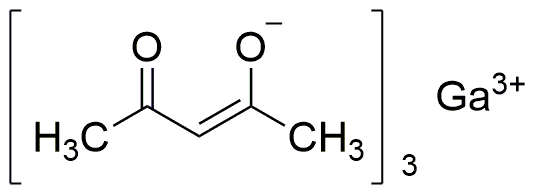Tris(2,4-pentanedionato)gallium(III) is widely utilized in research focused on:
- Thin Film Deposition: This compound is used in the production of thin films for electronic devices, such as semiconductors and solar cells, due to its ability to form high-quality gallium oxide layers.
- Chemical Vapor Deposition (CVD): It serves as a precursor in CVD processes, allowing for the controlled deposition of gallium-containing materials, which are essential in the fabrication of optoelectronic components.
- Biomedical Applications: The compound is explored for its potential in drug delivery systems and imaging agents, leveraging gallium's properties for targeted therapy in cancer treatment.
- Material Science: Researchers utilize it in the synthesis of novel materials, including gallium-based alloys and nanostructures, which can enhance the performance of various applications, from batteries to catalysts.
- Optoelectronics: It plays a crucial role in developing advanced optoelectronic devices, such as LEDs and laser diodes, owing to its favorable electronic and optical properties.
General Information
Properties
Safety and Regulations
Applications
Tris(2,4-pentanedionato)gallium(III) is widely utilized in research focused on:
- Thin Film Deposition: This compound is used in the production of thin films for electronic devices, such as semiconductors and solar cells, due to its ability to form high-quality gallium oxide layers.
- Chemical Vapor Deposition (CVD): It serves as a precursor in CVD processes, allowing for the controlled deposition of gallium-containing materials, which are essential in the fabrication of optoelectronic components.
- Biomedical Applications: The compound is explored for its potential in drug delivery systems and imaging agents, leveraging gallium's properties for targeted therapy in cancer treatment.
- Material Science: Researchers utilize it in the synthesis of novel materials, including gallium-based alloys and nanostructures, which can enhance the performance of various applications, from batteries to catalysts.
- Optoelectronics: It plays a crucial role in developing advanced optoelectronic devices, such as LEDs and laser diodes, owing to its favorable electronic and optical properties.
Documents
Safety Data Sheets (SDS)
The SDS provides comprehensive safety information on handling, storage, and disposal of the product.
Product Specification (PS)
The PS provides a comprehensive breakdown of the product’s properties, including chemical composition, physical state, purity, and storage requirements. It also details acceptable quality ranges and the product's intended applications.
Certificates of Analysis (COA)
Search for Certificates of Analysis (COA) by entering the products Lot Number. Lot and Batch Numbers can be found on a product’s label following the words ‘Lot’ or ‘Batch’.
*Catalog Number
*Lot Number
Certificates Of Origin (COO)
This COO confirms the country where the product was manufactured, and also details the materials and components used in it and whether it is derived from natural, synthetic, or other specific sources. This certificate may be required for customs, trade, and regulatory compliance.
*Catalog Number
*Lot Number
Safety Data Sheets (SDS)
The SDS provides comprehensive safety information on handling, storage, and disposal of the product.
DownloadProduct Specification (PS)
The PS provides a comprehensive breakdown of the product’s properties, including chemical composition, physical state, purity, and storage requirements. It also details acceptable quality ranges and the product's intended applications.
DownloadCertificates of Analysis (COA)
Search for Certificates of Analysis (COA) by entering the products Lot Number. Lot and Batch Numbers can be found on a product’s label following the words ‘Lot’ or ‘Batch’.
*Catalog Number
*Lot Number
Certificates Of Origin (COO)
This COO confirms the country where the product was manufactured, and also details the materials and components used in it and whether it is derived from natural, synthetic, or other specific sources. This certificate may be required for customs, trade, and regulatory compliance.

